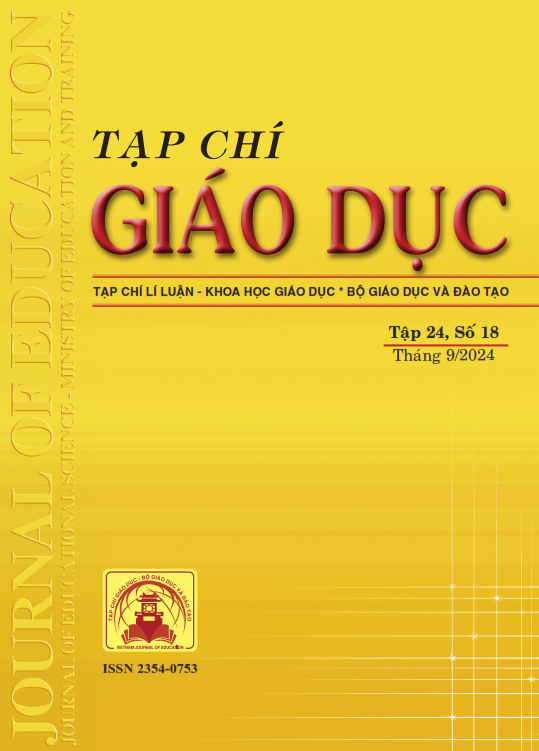Tiếp cận đa giác quan và dạy học viết văn miêu tả ở tiểu học theo hướng tiếp cận đa giác quan
Tóm tắt
The multisensory approach is a modern teaching trend that has been implemented in many countries around the world. This teaching strategy aimed at stimulating learners' senses has shown positive impacts in the teaching process across many different subjects. In the field of writing, multi-sensory teaching activities are also being studied and tested for effectiveness. This article presents some theoretical issues about the multisensory approach and the characteristics of descriptive writing to set a basis for applying this approach to teaching descriptive writing in primary schools. This is an appropriate direction in teaching Vietnamese in primary schools, meeting the requirements of developing learners' competence in the context of the 2018 General Education Curriculum for Literature.
Tài liệu tham khảo
Bộ GD-ĐT (2018). Chương trình giáo dục phổ thông môn Ngữ văn (ban hành kèm theo Thông tư số 32/2018/TT-BGDĐT ngày 26/12/2018 của Bộ trưởng Bộ GD-ĐT).
Dale, E. (1946). Audio-Visual Methods in Teaching. Dryden Press.
Dev, P. C., Doyle, B. A., & Valente, B. (2002). Labels needn't stick: “At-risk” first graders rescued with appropriate intervention. Journal of Education for Students Placed at Risk, 7(3), 327-332. https://doi.org/10.1207/ S15327671ESPR0703_3 3
Đào Duy Anh (1998). Từ điển Hán - Việt. NXB Khoa học Xã hội.
Fernald, G. M. (1943). Remedial Techniques in Basic School Subjects. McGraw-Hill.
Fleming, N. D., & Mills, C. (1992). Not Another Inventory, Rather a Catalyst for Reflection. To Improve the Academy, 11, 137-155. https://doi.org/10.1002/j.2334-4822.1992.tb00213.x
Fleming, N. D., & Bonwell, C. C. (2019). How Do I Learn Best?: a student's guide to improved learning. VARK Learn Ltd.
Hallahan, D. P., Kauffman, J. M., & Pullen, P. C. (2015). Exceptional Learners: An Introduction to Special Education (13th Edition). Pearson.
Hoàng Phê (chủ biên, 2003). Từ điển tiếng Việt. NXB Đà Nẵng.
International Dyslexia Association - IDA (2000). Multisensory teaching. https://ma.dyslexiaida.org/wp-content/uploads/sites/7/2016/03/Multisensory_Teaching.pdf
Kolb, D. A. (1984). Experiential Learning: experience as the source of learning and development. Prentice Hall.
Langille, J., & Green, Z. (2021). The Impact of Multi-Sensory Phonics Programs in Teaching English as an Additional Language. Canadian Journal of Education Revue Canadienne De l’éducation, 44(4), 1024-1050. https://doi.org/10.53967/cje-rce.v44i4.4723
Masters, K. (2013). Edgar Dale's Pyramid of Learning in medical education: A literature review. Medical Teacher, 35(11), e1584-e1593. https://doi.org/10.3109/0142159X.2013.800636
Nguyễn Minh Thuyết (tổng chủ biên, 2010). Tiếng Việt 5 (tập 1). NXB Giáo dục Việt Nam.
Nguyễn Thị Ly Kha, Trịnh Cam Ly (đồng chủ biên), Vũ Thị Ân, Trần Văn Chung, Phạm Thị Kim Oanh, Hoàng Thụy Thanh Tâm (2023). Tiếng Việt 4 (tập 2). NXB Giáo dục Việt Nam.
Pashler, H., McDaniel, M., Rohrer, D., & Bjork, R. (2008). Learning Styles: Concepts and Evidence. View All Authors and Affiliations, 9(3). https://doi.org/10.1111/j.1539-6053.2009.01038.x
Ritchey, K. D., & Goeke, J. L. (2006). Orton-Gillingham and Orton-Gillingham-Based Reading Instruction: A Review of the Literature. The Journal of Special Education, 40(3), 171-183. https://doi.org/10.1177/00224669060400030501
Shams, L., & Seitz, A. R. (2008). Benefit of multisensory learning. Opinion, 2(11), 411-417. https://doi.org/10.1016/j.tics.2008.07.006
Sprenger, M. (2008). Differentiation through learning styles and memory (2nd ed.). Thousand Oaks, CA: Corwin Press.
Stephen, K. (2000). On Writing: A Memoir of the Craft. Scribner.
Trần Thị Quỳnh Nga (chủ biên, 2023). Phiếu ôn tập cuối tuần môn Tiếng Việt lớp 4. NXB Giáo dục Việt Nam.
Trịnh Cam Ly (2018). Dạy học tập làm văn miêu tả cho học sinh lớp 4, 5 thông qua hoạt động trải nghiệm. Tạp chí Khoa học, Trường Đại học Sư phạm Hà Nội, Khoa học giáo dục, 63(8), 28-40.
Vũ Tú Nam, Phạm Hổ, Bùi Hiển, Nguyễn Quang Sáng (2004). Văn miêu tả và văn kể chuyện. NXB Giáo dục.
Tải xuống
Đã Xuất bản
Cách trích dẫn
Số
Chuyên mục
Giấy phép

Tác phẩm này được cấp phép theo Ghi nhận tác giả của Creative Commons Giấy phép quốc tế 4.0 .












